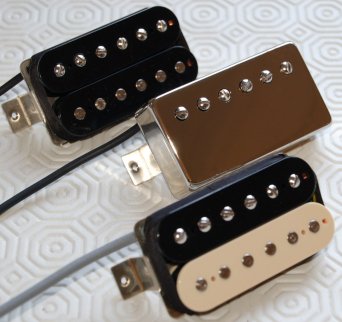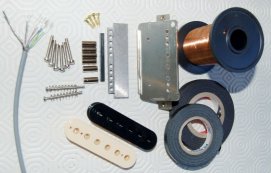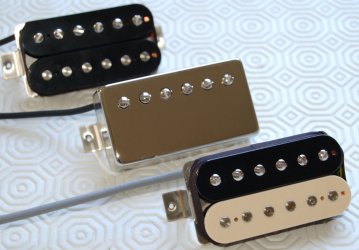How Pickups Work
How Pickups Work
Guitar pickups are very simple devices. Any coil of wire in a magnetic field can function as a guitar pickup.
Practical limits are imposed by the required output signal size and the physical size of the guitar.
The vibration of a metallic string within the magnetic field causes magnetic flux movements. These induce current in the coil of wire. This is always alternating current, with a frequency identical to the frequency of the vibration.
Guitar strings do not vibrate with a single frequency, but with many frequencies at the same time. These are the harmonic frequencies and also induce their own currents in the pickup coil.
Different pickups detect varying frequencies more or less efficiently and these are the characteristics that give a pickup its' distinctive tone.
Sound Variation
There are many factors that can affect the tone of a pickup. There are even more myths (or in some cases lies) claiming to hold the secret of good tone.
The size, shape and strength of the magnetic field affects the response of a pickup.
The material, size, amount of the wire and position of the coil windings affects the response of the pickup.
Almost everything else doesn't, unless it affects one of these two factors.

Basic Tones
Given a constant basic pickup design, these are the ways in which the main variables affect tone.
Stronger magnetic field - more volume, higher proportion of treble content. A stronger magnetic field also tends to change the mid bias towards the upper mids, producing a more focused tone and a stronger attack.
Larger magnetic field - greater range of harmonics captured, especially mid range and bass. Therefore higher proportion of mid-range and bass content.
Wire size (diameter). Smaller wire diameters produce a larger signal with less treble content for the same length of wire. If wound to the same impedance, they produce a smaller signal with more treble content. Finer wires also have a less pronounced resonant peak.
Depending on the difference in sizes, a smaller guage of wire may provide the opportunity to build a pickup that has more output and more treble content than a larger wire guage. This will occur within the range of same or greater impedance up to same number of turns of wire. One of the most important factors in tone is the resonant peak of a pickup. This is the frequency at which a pickup responds most strongly. A high resonant peak indicates a brighter tone, a low resonant peak, a darker tone. thinner wire produces a flatter EQ curve with a less pronounced resonant peak.
Impedance - we often see impedance figures quoted for pickups and take these to indicate pickup tone. Higher impedance equals more output, darker tone. In fact it is inductance that we should see, but this is very difficult to measure correctly and most inductance figures quoted are either calculated or for the coil only without taking into account the magnet system and . Like everyone else, I refer to impedance because it is convenient. The relationship between impedance and tone only holds for a given pickup design (single coil, twin coil, stacked coils), a given magnetic field and the same wire specification. Changing the magnet shapes and sizes or the wire diameter can very quickly destroy our preconceived ideas of how pickups should sound.
Magnet material - In itself, this has no effect. Alnico II doesn't sound any different than Alnico V or Ferrite. However, it does have a lower magnetic field strength if the magnet is approximately the same size. Differences in magnetic field strength and size do change the tone.
Coil size and shape - wider coils sense vibrations from a larger string length, increasing harmonic richness, particularly in the mid and bass. Narrower coils sense from a smaller string length, reducing harmonic richness but producing a higher treble content.

Twin coils automatically come into the large category. There are additional effects that change the tone of twin coil designs. Because these have two focuses on the strings, the two coils sense different frequencies to a greater or lesser degree. One focus may be near to the peak of a particular frequency harmonic and the other not. Combining two balanced focuses produces typical humbucker tones. There are partial phase cancellations, especially of very high frequencies, which is the reason humbuckers have less presence than single coils. The increased harmonic richness in the mid and bass frequencies leads to the fat, powerful sound we are used to.
Additional Factors
Unbalanced coils further modify the tone of a humbucker. This can be achieved by having an unbalanced magnetic field or unbalanced coil windings. Gemini pickups make extensive use of unbalanced coils as this technique allows flexible switching between different configurations. The results of unbalanced coils are changes in the resonant peak and changes in the partial phase cancellations compared to balanced coils. This can be used to produce humbuckers that sound slightly edgy and raw (small imbalance) or humbuckers that have high output but relatively low levels of mids (medium imbalance). Very large imbalances (more than 50%) produce sounds that are not typical for humbuckers at all but more typical of single coil pickups.
Hookup wires do have an effect on tone because the increased capacitance effectively reduces the inductance, lowers the resonant peak and makes the pickup sound slightly darker. The effect is insignificant, however, compared to the much higher capacitance of the guitar cable, especialy a 10m cable.
Insulation material has no effect whatsoever on tone. Using thicker insulation (e.g. formvar) on the coil wire has an indirect effect of making the coil larger, with the wire on average further from the centre of the magnetic field. Winding with a thicker poly insulation or a slightly faster traverse rate would produce exactly the same result.
Winding Tension doesn't directly affect tone. Indirectly, it tends to produce a physically larger or smaller coil and if excessive, it can stretch the wire, leading to higher impedance and darker tones.
Myths and Lies
Some of these have been in general circulation for a long time, some are used to try to sell you pickups.
Some of the myths are based on half truths, some on misconceptions and some are straight out lies.

Hand wound pickups sound better because they don't suffer from skin effect.
There is such a thing as skin effect. Skin effect describes the tendency of electrons to repel each other, leading to flow in the outer portion (skin) of a conductor. The suggestion is that this leads to higher impedance and too little treble on pickups that are not wound by hand.
There are three errors in this. Skin effect doesn't apply in coils, because of the repelling effects of the electrons in the next adjacent turn of wire. Where skin effect does apply, the depth of skin is dependant on the frequency of the current. In the relevant range (100 Hz to 20KHz) the minimum skin depth is over 1mm. However the wire used is less than 0.1mm in diameter. Thirdly, the suggestion that this is in any way affected by hand or machine winding is complete fantasy.
Hand wound pickups are better because they are scatterwound.
This is presumably based on the concept of distributed capacitance. The argument goes scatter winding reduces distributed capacitance and that lets more treble through because capacitance acts proportionally more against higher frequencies. The error lies in the assumption that hand winding is different. whether a pickup is machine wound or hand wound (hand guided would be a better term), the relevant factor is the number of turns per wrap (layer of wire). This depends primarily on the traverse rate. At a winding speed of 600 rpm a 4 second traverse equates to 40 turns per wrap, a 2 second traverse to 20 and a ten second traverse to 100 which would be close to the maximum possible. Whether a hand or a machine controls the traverse rate is not significant. It is just as easy to set the traverse rate on a CNC machine as by hand. The small amount of variation inherent in hand guiding makes no detectable difference if the winder is reasonably well practised.
Vintage correct materials and manufacturing techniques are essential for good tone.
Most of the materials have little or no effect on tone. Certainly, the use of cloth insulation on hookup wires doesn't. In addition, there is no justification for claiming that all vintage things were good and all new things are inferior. The idea that no-one has learned anything in fifty years is foolish. Many of the vintage style pickups available today are vastly superior to the majority of real vintage pickups and they can be expected to be consistent as well. Vintage pickups were mainly characterised by variability. While good and bad tone are subjective judgements, there is no possible argument for claiming that random variations produced consistently good results but that consistent design and manufacturing produces consistently bad results.

The best pickups are produced by black magic
This is, of course, absolutely true. All of the Gemini modern are designed based on the number of the beast. A variety of arithmetic derivatives of 666 are carefully applied to the design to ensure the optimum combination of mojo, ju-ju and voodoo is guaranteed for each pickup. This is why Gemini pickups are better than everyone else's. Not only do they sound better but they may well enhance both your playing and your love life.
The exception is vintage models as black magic is not vintage correct technique. In fact, it wouldn't work anyway. Vintage pickups are wound using AWG 42 wire. As everyone knows 42 is the answer to life, the universe and everything and therefore clearly not subject to modification by the number of the beast.
